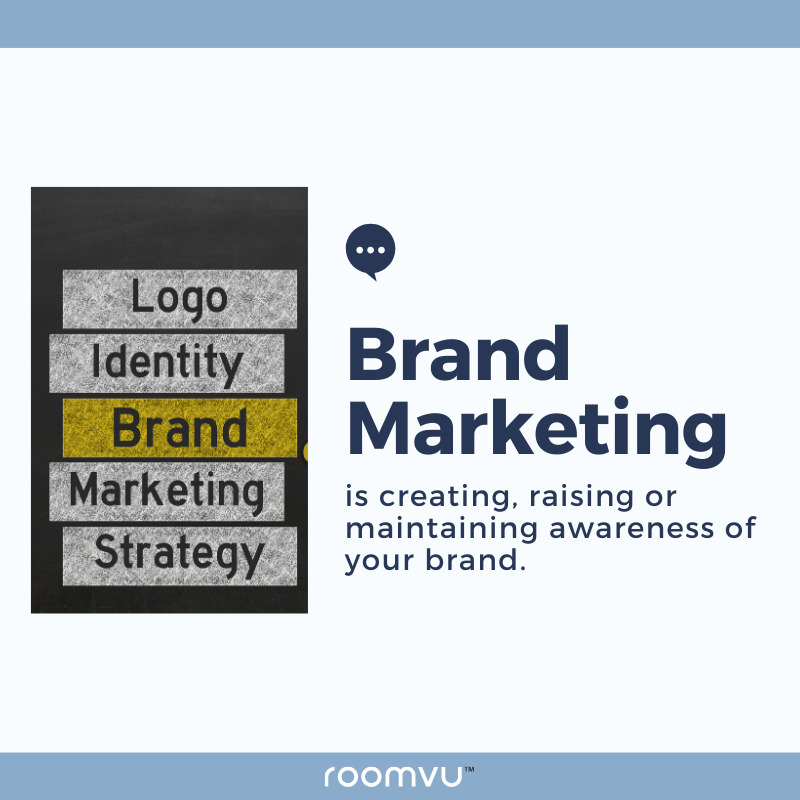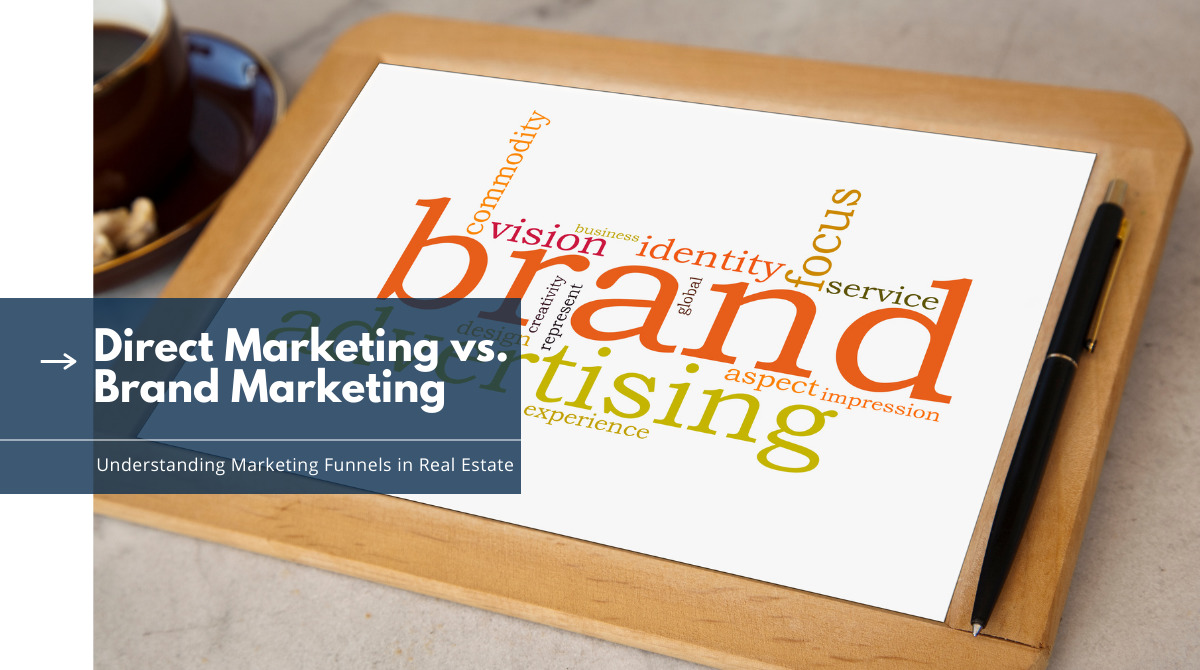When you are marketing products and services for a business, it will be very easy to mix up direct marketing and brand marketing. Often in real estate, agents confuse these two and use them interchangeably while they are quite different.
They run a direct marketing campaign and expect branding results or the other way around. It causes frustration and disappointment making them forget about marketing.
In this article, we will discuss the difference between the two concepts and when to practice each, especially when you are paying for them.
The Root of The Problem
Real estate agents can get too caught up with their brand – just like many CEOs in small businesses. They may end up spending their entire budget without knowing where the money has gone. As a smart agent and business owner, you should always ask:
How much of your annual sales volume can be attributed to your marketing initiatives?
Was that billboard or bus station advertising worth it? What about your social media? Can you measure if you’re investing in your real estate business or just wasting money?
In order to understand and measure your marketing efforts, first we need to know the difference between Brand Marketing and Direct Response Marketing.
Brand Marketing or Direct Marketing in Real Estate?
In this article, we’ll try having a more accessible approach while explaining in a way that’s helpful for your business and relevant to the marketing industry.
So what is brand marketing in simple words?
In a nutshell, brand marketing is creating, raising or maintaining awareness of your brand.
When you are working on brand awareness, the money spent on marketing may not directly lead to sales. You are establishing a long term reputation and it takes time and effort to build up a popular brand.

The idea behind brand marketing is creating brand affinity and top of mind awareness. With brand marketing, You are creating awareness so that when your target audience needs real estate services. You can also stay on top of their mind and they will call you but that’s probably not going to happen right away.
Read More: Successful Real Estate Marketing Ideas and Examples to Get Leads In 2020
Think of the time you go to the grocery store. You want a drink. Do you pick up the first drink you see or do you prefer some brands over others?
We all have some brands on top of our minds. That’s the result of brand marketing and while you cannot exactly measure how much you’ve contributed to sales when investing in brand marketing, it is absolutely necessary to dedicate resources to it.
What is direct (response) marketing in simple words?
Direct marketing is defined as all measurable activities that can be directly attributed to sales.
This type of marketing has especially gained attention and popularity with the rise of digital marketing channels such as email, social media and Google platforms.
Digital channels give you the chance to measure marketing activities more effectively and accurately.
“Direct marketing is designed in such a way that its direct impacts on sales can be measured.”
Now that you know the difference between direct and brand marketing, you want to know the best way to approach your marketing activities. You should be able to dedicate proper budget to both and expect reasonable results. That can be done by knowing what a marketing funnel is.
Read More: Real Estate Digital Marketing Best Practices: Converting Leads Effectively
Marketing Funnel: a Journey From Brand Awareness to Becoming a New Client
Every client has a journey from the first interaction with you to becoming your client:
The notion of marketing funnel has evolved through the past few decades especially with the rise of digital marketing but here we simplify it as a 3 step process:
Almost every new lead goes through the steps above and becomes a client.
From a marketing perspective, you should be able to consider necessary touchpoints and have a plan for each step to maximize the efficiency of your campaigns.
Step 1: Awareness
Awareness in the marketing funnel is the first time a prospect hears about you. It is considered as the Top Of Funnel (TOFU) layer.
Let’s consider a well-known scenario: referral
You sold a house to Fred last year. You offered extra care and now he has introduced you to his cousin Jenny.
You don’t have to create awareness for Jenny anymore because Fred made that happen. Now Jenny has moved to the next step in the funnel: Research & Consideration
All you have to do for her is maintain awareness and make sure that you remain on top of her mind. This can be done by ongoing awareness and consideration campaigns.
The same goes with your social media platforms. If Jenny sees your Facebook ad or likes your Instagram post, then your social media has done the introduction. Your Instagram is the touchpoint and you have created brand awareness with social media.
Instagram, LinkedIn or Facebook are channels with which you can build your brand awareness and are places to find more potential leads. Whoever likes your page or follows you, might not become a client immediately but are placed in the awareness stage.
It takes time to establish your awareness with social media marketing and it needs consistency and patience.
Digital Channels for Brand Awareness
- Social media Posts
- Facebook and Instagram Ads (for awareness)
No matter what medium you choose, you won’t be able to measure the impact on your sales directly. Keep in mind that you are increasing awareness especially if it’s the first touchpoint. So the dollars you spend today won’t necessarily lead to sales the next week or month.
Step 2: Research & Consideration
Back to our story. Either through a referral or a Facebook ad, now Jenny needs to know more about you. So she does her research to evaluate you.
She searches your name or your real estate brand. She might talk to the other clients who provided testimonials or she might read up on you online.
The million dollar question:
How are you building your digital (online) brand?
Just like the Awareness phase, the budget spent in the Consideration phase may not directly result in sales – nurturing process.
Digital Channels to Improve Consideration
- Website
- Social media
Your website is a hub of all your online activities. You need to make sure that you have created a welcoming environment and also address any questions and concerns visitors might have.
Social media channels such as Instagram or LinkedIn are tools to send prospects from the Awareness phase to the final step: Action.
Step 3: Action or Purchase
Now Jenny is ready to discuss the details of her future home with you. This is the last step where you can close the sale.
This could be by filling out a lead capture form or simply calling you to schedule a meeting.
Digital Channels to Increase Sales
- Facebook/Instagram Ads (for leads)
- Lead capture landing pages
As you must have noticed, different platforms can both be used for direct marketing and brand marketing. The difference between the two lies within the expectations you have and it depends highly on your business and what you expect.
You can run a Facebook ad to increase awareness of your brand or to capture leads on lead generation landing pages. In fact, Facebook’s platform has evolved in the past few years in such a way that allows you to create advertising campaigns for every step of the marketing funnel.
For instance, you can ask Facebook to target people who are more likely to take action and become a lead but this only happens if you’ve already created awareness & trust for your brand.
If you are running an awareness campaign, you need to keep running your ads for some time to establish trust. Going through the consideration and action phases takes some time and you must be patient as you are with other channels.
Each ad has its own place and should be used properly in its correct place in your marketing strategy. However, consistency is key in both direct marketing and brand marketing.
Direct Marketing Vs. Brand Marketing for Real Estate: Final Words
Direct marketing and brand marketing are both necessary for your real estate business, however, they have different goals. Direct marketing aims at making people buy your products and services. You can measure how effective your direct marketing campaign has been.
Brand marketing on the other hand does not aim at making immediate sales. It is trying to increase awareness of your brand or simplify the research and consideration process.
Brand Marketing focuses on building a sense of trust and familiarity and should be accompanied by direct (response) marketing activities to lead to sales.
Read More: Real Estate Content Marketing Ultimate Guide 2020

